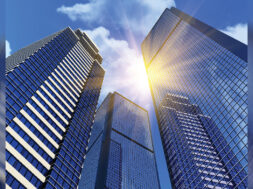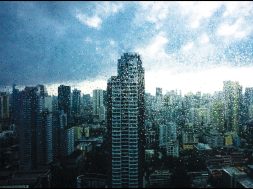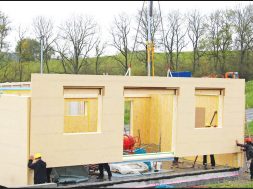High-rise buildings in vibrant urban layouts

Leading experts across the architectural industry are sharing their insights on paving the way for innovative designs and cutting-edge technologies that shape the future of high-rise living.
As the world’s urban landscapes evolve and cities expand vertically, the role of high-rise buildings in shaping modern societies becomes increasingly pivotal. Architects and designers are at the forefront of this architectural revolution, reimagining high-rise structures as vibrant urban ecosystems that embrace sustainability, connectivity, and energy efficiency. Designing Sustainable High-Rise Marvels.
Pooja Nikhar, a Senior Associate at Morphogenesis, firmly believes sustainable design approaches are essential in shaping high-rise buildings. Amidst global challenges like the COVID-19 pandemic, she emphasises the urgency to encourage mixed-use developments in high-rise structures. This versatile approach ensures flexibility to cater to diverse needs and embraces future generations’ future requirements. With the sky becoming the new frontier, Pooja sees an opportunity to elevate the public realm within high-rises by incorporating terraces and communal spaces that foster a sense of community among occupants. She advocates for shifting from conventional glass buildings to passive design strategies that respond to the local climate and surroundings. Pooja envisions a more integrated and ecologically conscious urban landscape by harmonising modern high-rise architecture with sustainable practices.
According to Ar. Kshiti Bhargava, a Senior Architect at Arcmax Architects & Planners, is the significant responsibility architects bear when designing high-rise buildings, particularly in a country like India. She compares the North and South Poles metaphorically to emphasise architects’ dual challenges. This technology shapes the end product and the mental energy efficiency needed to connect with users. Bhargava stresses the importance of preserving the connection to the ground, a deeply ingrained aspect of Indian culture. As high-rises become a reality, architects must spread awareness about the possibilities of touching the skies without losing sight of the ground beneath. Balancing innovation with the ground reality is essential in creating sustainable, user-friendly, high-rise structures that resonate with people.
While emphasising on the challenges Mr. Raaghav N., CEO of A PLUS R Architects, delves into the critical challenge of establishing robust ground connectivity for high-rise buildings. With the demand shifting towards luxury living and residents seeking the comforts of high-rise villas, Raaghav emphasises creating an inclusive environment that caters to all sectors, including affordable housing. He stresses the significance of ground connectivity, comfort, and accessibility to create high-rise marvels that align with the aspirations of residents. Emphasising the need for innovation and technology, Raaghav advocates for data-driven design approaches that optimise occupant experiences and energy efficiency.
In the ongoing discussion of embracing integration and sustainability, Mr. Sarfaraz Shaikh, Director of Ambrosia Designs, echoes the sentiments of his peers, highlighting the need for integrated high-rise structures that transcend traditional residential and commercial concepts. He envisions high-rises as dynamic ecosystems, seamlessly blending hotels, commercial spaces, and residential areas. To achieve this vision, Shaikh collaborates with experts in structural and mechanical, electrical, and plumbing (MEP) consultants to address the challenges of services in high-rise designs. By embracing innovative technologies and sustainable practices, Shaikh aims to create high-rises that stand tall in the skyline and foster meaningful connections with the ground and surroundings.
As the world increasingly focuses on energy efficiency and sustainable practices, experts explore cutting-edge advancements in building materials, installations, and HVAC systems that promise significant reductions in energy consumption for high-rise buildings. From the MEP perspective, Mr. Sheikh delves into the crucial role of HVAC systems in energy consumption. He highlights the potential for energy savings by implementing cooling water systems and modular water-cooled chillers. Solar power integration emerges as a game-changer, as experts like Raaghav emphasise the potential for significant energy generation and cost savings for high-rise buildings. Integrating innovative technologies and energy-efficient methods heralds a transformative era in high-rise architecture.
The convergence of sustainability and innovation heralds a high-rise revolution. Architects push boundaries, redefining skyscrapers with thoughtful design and eco-consciousness. With each story they craft, they envision vibrant urban ecosystems that connect with the ground and create seamless user experiences. From mixed-use spaces to climate-responsive facades, the journey towards a sustainable high-rise future is paved with innovation, inclusivity, and a sense of responsibility towards the environment and future generations. As cities continue to reach for the skies, architects stand as beacons of change, inspiring a new era of high-rise living that strikes a harmonious balance between human aspirations and environmental preservation. The future of high-rise buildings is one of integrated sustainability, where each structure becomes a testament to the collective responsibility of creating a better world.
The architects’ insights underscore high-rise buildings’ crucial role in creating vibrant urban ecosystems. Their focus on sustainability, innovation, and ground connectivity highlights the need for a balanced approach to high-rise design. As cities continue to evolve, these visionary architects are paving the way for a future where high-rise structures not only reach for the skies but also harmonise with the surrounding environment, fostering a more inclusive and sustainable urban landscape.
48
Cookie Consent
We use cookies to personalize your experience. By continuing to visit this website you agree to our Terms & Conditions, Privacy Policy and Cookie Policy.










